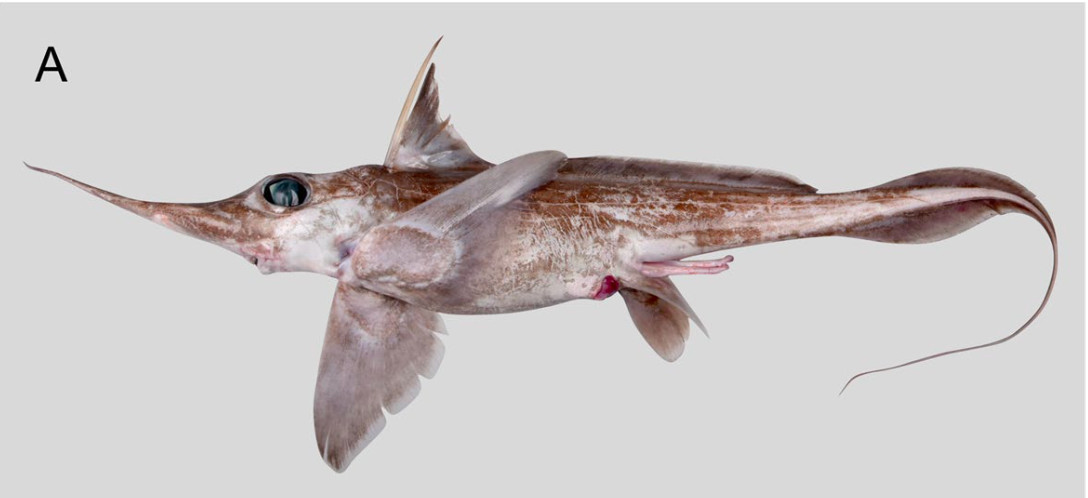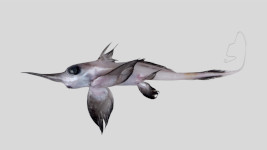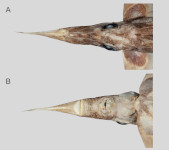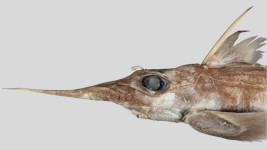Harriotta avia
Finucci, Didier, Ebert, Green, & Kemper, 2024
Classification: Holocephali Chimaeriformes Rhinochimaeridae
Reference of the original description
Harriotta avia sp. nov. – a new rhinochimaerid (Chimaeriformes: Rhinochimaeridae) described from the Southwest Pacific. Environmental Biology of Fishes, 107, 841–865
Harriotta avia sp. nov. – a new rhinochimaerid (Chimaeriformes: Rhinochimaeridae) described from the Southwest Pacific. Environmental Biology of Fishes, 107, 841–865
Types
Harriotta avia
Holotype: NMNZ: P.061676; Paratype: AIM: MA73690 (ex NMNZ P.061377); BMNH: 2023.6.10.1 (ex NMNZ P.005695); CAS: ICH 248066 (ex NMNZ P.012141); CSIRO: H 92171–01 (ex NMNZ P.061681); NMNZ: P.041469; NMNZ: P.061726; NMNZ: P.061672; NMNZ: P.061677; NMNZ: P.061673; NMNZ: P.061680; NSMT: P 147389 (ex NMNZ P.026883);
Harriotta avia
Holotype: NMNZ: P.061676; Paratype: AIM: MA73690 (ex NMNZ P.061377); BMNH: 2023.6.10.1 (ex NMNZ P.005695); CAS: ICH 248066 (ex NMNZ P.012141); CSIRO: H 92171–01 (ex NMNZ P.061681); NMNZ: P.041469; NMNZ: P.061726; NMNZ: P.061672; NMNZ: P.061677; NMNZ: P.061673; NMNZ: P.061680; NSMT: P 147389 (ex NMNZ P.026883);
Description :
Citation: Harriotta avia Finucci, Didier, Ebert, Green, & Kemper, 2024: In: Database of modern sharks, rays and chimaeras, www.shark-references.com, World Wide Web electronic publication, Version 12/2025
Please send your images of "Harriotta avia" to info@shark-references.com

Harriotta avia Finucci, Didier, Ebert, Green, & Kemper, 2024, NMNZ P.061676, holotype, male, 296 mm BDL, from Chatham Rise, New Zealand, 630–641 m, fresh © C. Struthers, NMNZ (Te Papa)

Harriotta avia Finucci, Didier, Ebert, Green, & Kemper, 2024, NMNZ P.061676, holotype, male, 296 mm BDL, from Chatham Rise, New Zealand, 630–641 m, fresh © C. Struthers, NMNZ (Te Papa)
Common names
 Australasia Narrow-nosed Spookfsh
Australasia Narrow-nosed Spookfsh
 Australasia Narrow-nosed Spookfsh
Australasia Narrow-nosed Spookfsh
Short Description
Original diagnosis of Finucci, Didier, Ebert, Green, & Kemper, 2024 [33418]: Harriotta avia sp. nov. is distinguished from its congeners by the following combination of characters: elongated, narrow and depressed snout up to 56% BDL; long, slender trunk; beak-like vomerine tooth plate; large eye, length 8–12% BDL and height 5–7% BDL; long dorsal spine reaching slightly beyond apex of the dorsal fn; slender rod-like pelvic claspers. Deciduous skin; uniform chocolate brown when skin intact.
Original diagnosis of Finucci, Didier, Ebert, Green, & Kemper, 2024 [33418]: Harriotta avia sp. nov. is distinguished from its congeners by the following combination of characters: elongated, narrow and depressed snout up to 56% BDL; long, slender trunk; beak-like vomerine tooth plate; large eye, length 8–12% BDL and height 5–7% BDL; long dorsal spine reaching slightly beyond apex of the dorsal fn; slender rod-like pelvic claspers. Deciduous skin; uniform chocolate brown when skin intact.
Dentition
Upper anterior tooth plates (vomerine tooth plates) broad, incisor-like with 9 (8–11) tritor rods visible (sometimes very weakly defned); posterior upper tooth plates (palatine) with a longitudinal groove along its medial margin and an ovoid swollen area centrally, 3 (up to 6) prominent weak tritor rods on anterior margins; lower tooth plates (mandibular) incisor-like with 3 (about 4) tritor rods visible at the beak like tip, and 6 (6 or more) tritor rods visible posteriorly; pale greyish in colour [33418]
Upper anterior tooth plates (vomerine tooth plates) broad, incisor-like with 9 (8–11) tritor rods visible (sometimes very weakly defned); posterior upper tooth plates (palatine) with a longitudinal groove along its medial margin and an ovoid swollen area centrally, 3 (up to 6) prominent weak tritor rods on anterior margins; lower tooth plates (mandibular) incisor-like with 3 (about 4) tritor rods visible at the beak like tip, and 6 (6 or more) tritor rods visible posteriorly; pale greyish in colour [33418]
Remarks
shark-references Species-ID=17435;
shark-references Species-ID=17435;





















